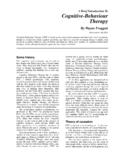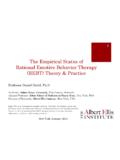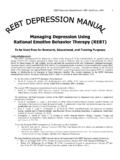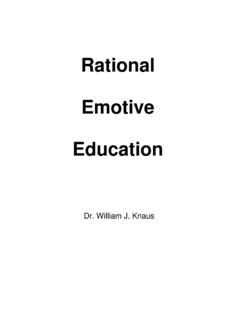Transcription of A Brief Introduction To Rational Emotive Behaviour Therapy
1 Page 1 of 15 A Brief Introduction To Rational Emotive Behaviour Therapy By Wayne Froggatt Third Ed.(this version Feb 2005) Rational Emotive Behaviour Therapy (REBT) is based on the concept that emotions and behaviours result from cog-nitive processes; and that it is possible for human beings to modify such processes to achieve different ways of feel-ing and behaving. REBT is one of a number of therapies that come under the heading cognitive-behavioural . In the mid-1950 s Dr. Albert Ellis, a clinical psy-chologist trained in psychoanalysis, became disil-lusioned with the slow progress of his clients. He observed that they tended to get better when they changed their ways of thinking about themselves, their problems, and the world. Ellis reasoned that Therapy would progress faster if the focus was directly on the client s beliefs, and thus was born the method now known as Rational Emotive Be-haviour Therapy .
2 REBT was originally called Rational Ther-apy , soon changed to Rational - Emotive Ther-apy and again in the early 1990 s to Rational Emotive Behaviour Therapy . REBT is one of a number of cognitive-behavioural therapies, which, although developed separately, have many similarities such as Cognitive Therapy (CT), developed by Psychiatrist Aaron Beck in the 1960 s. REBT and CT together form the basis of the family of psychotherapies known as Cogni-tive- Behaviour Therapy . Over the past half-century, REBT has developed significantly, and continues to change. Theory of causation REBT is not just a set of techniques it is also a comprehensive theory of human Behaviour . REBT proposes a biopsychosocial explanation of cau-sation that a combination of biological, psy-chological, and social factors are involved in the way humans feel and behave.
3 The most basic premise of REBT, which it shares with other cognitive-behavioural theories, is that almost all human emotions and behaviours are the result of what people think, assume or believe (about themselves, other people, and the world in general). It is what people believe about situations they face not the situations themselves that de-termines how they feel and behave. REBT, however, also argues that a person s biology also affects their feelings and behaviours an important point, as it is a reminder to the therapist that there are limitations to how far a human being can change. A person s belief sys-tem is seen to be a product of both biological in-heritance and learning throughout life. A useful way to illustrate the role of cognition is by using Ellis ABC model. In this framework A represents an actual event or experience, and the person s inferences or interpretations as to what is happening.
4 B represents the evaluative beliefs that follow from these inferences. C represents the emotions and behaviours that fol-low from those evaluative beliefs. Here is an example of an emotional episode , experienced by a person prone to depression who tends to misinterpret the actions of other people: A1. Activating event what happened: Friend passed me in the street without ac-knowledging me. A2. Inferences about what happened: He s ignoring me. He doesn t like me. B. Beliefs about A: I m unacceptable as a friend so I must be worthless as a person. (Evaluation) C. Reaction: Emotions: depressed. Behaviours: avoiding people generally. Page 2 of 15 Note that A alone does not cause C A triggers off B , and B then causes C . Also, ABC episodes do not stand alone: they run in chains, with a C often becoming the A of an-other episode we observe our own emotions and behaviours, and react to them.
5 For instance, the person in the example above could observe their avoidance of other people, interpret this as weak, and engage in self-downing. Note, too, that most beliefs are outside con-scious awareness. They are habitual or automatic, often consisting of underlying rules about how the world and life should be. With practice, though, people can learn to uncover such subcon-scious core beliefs. Theory of change According to REBT, change can occur at different levels. Let s say, for instance, that you are anx-ious because you think someone is disapproving of you. At a superficial level you can feel better by altering your body chemistry ( via exercise, dietary change or medication); by changing the situation ( by avoiding contact with the other person); or by changing your inferences about the situation (for example, you make yourself feel less anxious by convincing yourself that the dis-approval isn t going to happen).
6 For a person to go beyond feeling better to ac-tually get better that is, to achieve fundamental and lasting change involves modifying the un-derlying core beliefs that create difficulties for them in a range of situations. Using our example above, rather than convince yourself that disap-proval isn t going to happen, you accept that it might, but deal with your underlying core belief that you need approval and must not ever receive disapproval. REBT therapists accept that superficial change may sometimes be the more realistic option for some clients, but aim for fundamental change wherever possible. To achieve such change, REBT uses a range of cognitive, Emotive and be-havioural strategies (more about these later). What is irrational thinking? We have seen that what we think determines what we feel.
7 But what types of thinking are problem-atical for human beings? A definition To describe a belief as irrational is to say that: 1. It blocks a person from achieving their goals, creates extreme emotions that persist and which distress and immobilise, and leads to behaviours that harm oneself, others, and one s life in general. 2. It distorts reality (it is a misinterpretation of what is happening and is not supported by the available evidence); 3. It contains illogical ways of evaluating oneself, others, and the world: demandingness, awfulis-ing, discomfort-intolerance and people-rating; When talking with clients, we often refer to beliefs as self-defeating rather than irrational , to emphasise that the main reason for replacing a belief is because it negatively affects their lives. Two Types of Disturbance REBT suggests that human beings defeat or dis-turb themselves in two main ways: (1) by holding irrational beliefs about their self (ego distur-bance) or (2) by holding irrational beliefs about their emotional or physical comfort (discomfort disturbance).
8 Frequently, the two go together people may think irrationally about both their selves and their circumstances though one or the other will usually be predominant. Ego disturbance represents an upset to the self-image. It results from holding demands about one s self , I must .. do well / not fail / get approval from others ; followed by negative self-evaluations such as: When I fail / get disapproval / etc. this proves I am no good and so on. These beliefs create ego anxiety emotional tension resulting from the perception that one s self or personal worth is threatened and lead to other problems such as avoidance of situations where failure, disapproval, etc. might occur; looking to other people for acceptance; and unassertive Behaviour through fear of what others may think.
9 Discomfort disturbance results from demands about others ( People must treat me right ) and about the world ( The circumstances un-der which I live must be the way I want ). Dis-comfort disturbance comes in two slightly differ-ent but related flavours: Low frustration-tolerance (LFT) results from demands that frustration not happen, followed by catastrophising when it does. It is based on beliefs like: The world owes me contentment and happiness; or: Things should be as I want them to be, and I can t stand it when they are not. Low discomfort-tolerance (LDT) arises from demands that one not experience emotional or physical discomfort, with catastrophising when discomfort does occur. It is based on be-liefs like: I should be able to feel happy all the time; I must be able to feel comfortable Page 3 of 15 all of the time; Discomfort and pain are aw-ful and intolerable, and I must avoid them at all costs; I must not feel bad; and so on.
10 The two types LFT and LDT are similar and closely related (often one expression is used to refer to both). Discomfort disturbance leads to problems like: Discomfort anxiety (emotional tension re-sulting from the perception that one s comfort (or life) is threatened). Worrying ( because .. would be awful, and I couldn t stand it, I must worry about it in case it happens ). Avoidance of events and circumstances that are seen as too hard to bear or too difficult to overcome. Secondary disturbance (upsetting oneself about having a problem, becoming anx-ious about being anxious, depressed about be-ing depressed, and so on). Short-range enjoyment the seeking of im-mediate pleasure or avoidance of pain at the cost of long-term stress for example alcohol, drug and food abuse; watching television rather than exercising; practising unsafe sex; or overspending to feel better.





